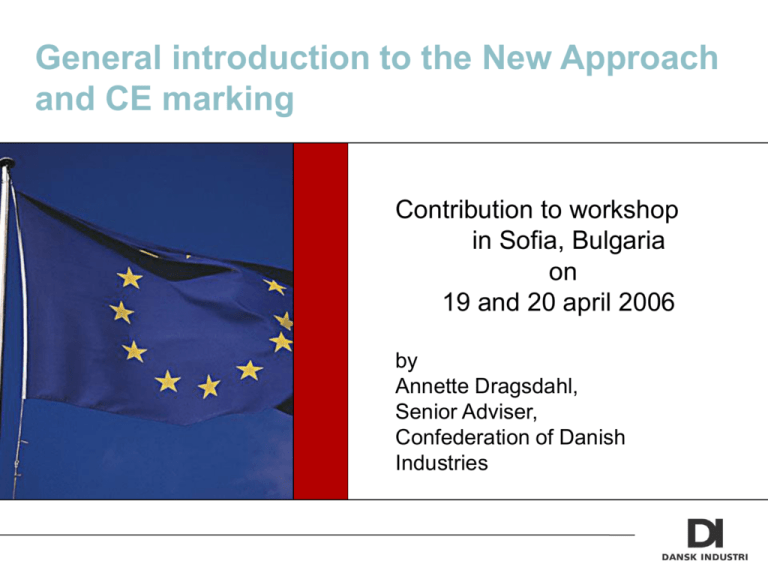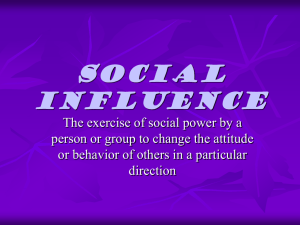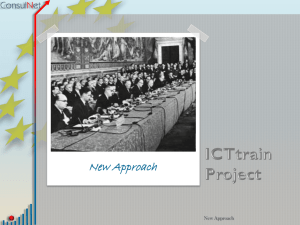A new philosophy for completing the internal market for products
advertisement

General introduction to the New Approach and CE marking Contribution to workshop in Sofia, Bulgaria on 19 and 20 april 2006 by Annette Dragsdahl, Senior Adviser, Confederation of Danish Industries Outline of presentation • • • • • Brief introduction to DI and own background Creating a single market New Approach directives, in general CE-marking and the conformity assessment procedure Revision of the New Approach Political Influence DI - The Voice of Danish Industry "DI was the first organisation in Denmark to fully adapt to the vital nature of specialist knowledge." DI is a private organisation funded entirely by its 6,400 member companies. We are more than 400 employees. Ove Kaj Petersen, Professor of Political Science, University of Copenhagen DI promotes the views of industry locally, nationally and internationally. Source: Berlingske Tidendes Nyhedsmagasin, December 2002 DI aims at providing the best possible working conditions for Danish industries. DI in Brussels • Own office in Brussels (5 persons) • All issue managers active also in Brussels DI is a member of: • UNICE (horisontal) • Orgalime (mechanical, electrical and electronical industries) • European sector federations, e.g. ITC, food and construction Own background Work in the European Affairs unit of DI • Horisontal, Internal Market policy • Directives under the New Approach (technical safety) • Standardisation • Certification • Accreditation policies • Metrology • Barriers to Trade (IM and global) All areas include informative, advisory and political work Creating a single market • Free movement of goods is a cornerstone of the Single Market • Abolishing customs duties not enough • National technical regulations were increasing in the 70'ies and became technical barriers to trade • Technical harmonisation on Community level is needed to avoid barriers • Detailed legislation takes time… • A new philosophy was born… Rules and regulations for products in the Single Market • Mutual recognition – Acceptance in each Member State of products lawfully manufactured in the rest of the Community – Applies to: • test results and certificates • legislation • Harmonisation – Old Approach – New Approach combined with the Global Approach for conformity assessment • Monitoring national regulations – A preventive procedure including notifications (directive 98/34) The New Approach: A new regulatory technique • Stimulates industrial development – Flexibility – Invites for innovations and modifications • Based on confidence • Pre-market procedures to be balanced by efficient market surveillance by national authorities • Comprises a whole system: – – – – Risk assessment and conformity assessment by the manufacturer Notified bodies, if required National authorities to ensure market surveillance European co-operation to ensure level playing field NB: Guide to implementation of directives – Specifies the principles and tasks of the different actors New Approach directives • Deal with important economic sectors/product areas • Define the essential requirements for the product (covering health, safety and the environment, in particular) • Technical details to be fixed in European standards • Voluntary use of standards (in principle) • Specify the requirements for conformity assessment – Different modules depending on the type of products and the risks involved, cf. the Global Approach – Main principle: Module A - Internal design control – European standards give presumption of conformity – For certification, if required: Reference to Notified Bodies • CE-marking (21 out of 25 directives) What is CE-marking? • The CE-marking symbolises the conformity of the product with the applicable Community requirements • Originally addressed to authorities • When affixed to products = declaration by the manufacturer that the product conforms to all applicable provisions • For the buyer/consumer: = a signal that EU regulation exists and that the manufacturer has done what he can to ensure that the product meets the requirements CE-marking procedure • Specify appropriate directives (download text from europa.eu.int/eur-lex) • Define appropriate standards (harmonised, if any) • Determine applicable essential requirements • Carry out risk assessment (eliminate or reduce risks, or…); for machinery see EN 1050 • Fulfil conformity assessment procedure • Establish technical file • Instructions for use, handling, maintenance etc. • Declaration of conformity • CE-marking Revision of the New Approach • 20 years' practice has shown a need for improving the system: – – – – – Efficient market surveillance Common definitions Coherent requirements Uniform requirements for Notified Bodies Clarification of the role of the different economic operators • Possible extension to other areas in line with the "Better Regulation" initiative • Regulation in stead of directives? Thank you for your attention!








